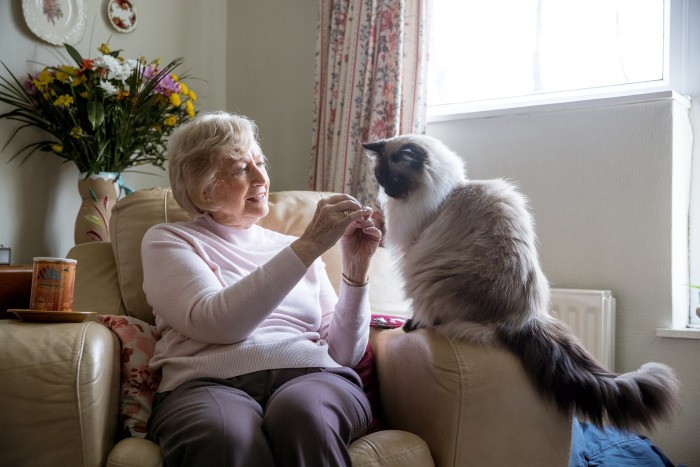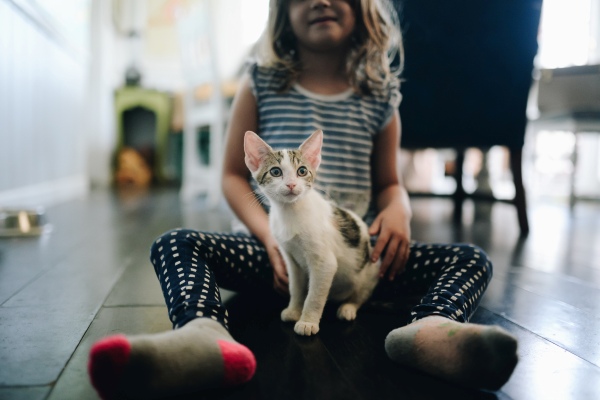Introducing Cats to Each Other
First impressions matter when it comes to cat introductions. It’s better to go slow and control the process than to get off to a rocky start and try to reboot. If that happens, though, still follow the process below and stay patient.
Experts agree that the most important thing you can do when introducing cats to each other is to keep them apart at first. Current cats should get used to the newcomer’s scent and vice versa before there is first sight.
Introducing new cats to each other comes down to a three-step process: separate spaces, smelling each other, and seeing each other.
1.Separate Spaces: Keep the New Cat and Your Current Cats Apart
Prepare a separate space for your new kitty before you bring him home. Make sure to set up a food bowl, water bowl, litter box, toys, soft places for naps such as a blanket and towels, and a scratching post or pad. This space should be separate from the rest of the home and behind a closed door away from the other cats.
“It’s also a good idea to provide a few hiding places in case the new cat is nervous in the unfamiliar environment. An open cat carrier is one option. You can also use a box placed on its side and lined with a soft towel,” advises Pam Johnson-Bennett, Certified Cat Behavior Consultant and best-selling author.
At first, the new cat will adjust to this smaller space that becomes his territory, while the other cat(s) maintain their turf, minus the room the newcomer occupies. The other cats will know something is up, though. Cats are very sensitive to shifts in smells and energy and will be quite aware that another cat is on the other side of the door. To help keep a lid on stress, use playtime or offer treats if your current cat gets agitated.
The cats will begin to interact with each other through the closed door, which leads to the second step.
2.Smell-Sharing: Introduce Cats to their Scents First
Under and around the closed door, the new cat and the current cats will begin to get used to the others’ scents. The cats might become quite obsessed with the door and what’s on the other side – a curious new change in the home. You might even see paws reaching under the door exploring, and some tentative touching. Johnson-Bennett stresses that it’s important not to let the current cat(s) camp out at the new cat’s door if they appear upset or aggressive.
You may also see some flat ears, hunkered bodies, and running away. If either cat is nervous or unenthused by the other, use distraction with toys or treats. If the cats can’t be distracted, provide more separation and slow down the introduction process.
Consider feeding the cats on either side of the door. Place the current cat’s dish within sight of the new cat’s door but not too near. “Cats aren’t social eaters so asking them to have a meal in close proximity may increase feelings of being threatened. Watch your cat’s reaction so you’ll know how close to place the bowl. If a cat stops eating or appears nervous then you’ve placed it too close. Gradually work on decreasing the distance. At the right distance, this can help cats start to associate good things with each other,” says Johnson-Bennett.
You can also sit with each cat on one side of the door and interact positively with them, playing, giving treats and petting, depending on each cat’s comfort level. “Proceed at the pace of the most nervous of the cats and don’t rush the process,” she advises.
When we talked about setting up a space for your new cat above, we mentioned including towels and a blanket. In addition to providing a soft and comfy place for your new kitty to snuggle, these items are strategic scent-gatherers! After a couple days, take a small towel with the new cat’s scent on it and bring it into the main area with the other cats.
At the same time, bring a small hand towel containing the current cat’s scent into the new cat’s territory. This step helps them get used to the other cat’s scent within their own spaces. Johnson-Bennett suggests collecting scents by gently rubbing a cat around the cheeks to collect facial pheromones. She advises not to rub one cat with another cat’s scented towel, though. Just leave the small towel in the area for cats to investigate on their own.
Johnson-Bennett offers this additional tip to continue the all-important scent gathering through exploration phase. “Place your current cat(s) in a separate area of the house and then open the new cat’s room so he can begin venturing out to get familiar with the new surroundings. These brief outings allow the new kitty to spread his scent, as well as learn more about the current cat’s scent and the layout of the house. If the new cat seems nervous about exploring, gently coax him using an interactive toy and/or treats. Let the cat go at his own pace and don't push. This exploration lets the newcomer do some facial rubbing on objects so he can start adding his scent into the kitty household.”
Remember: just as with people, you can’t force two cats to like one another. You can provide space and safety for a friendship to naturally develop at a pace at which both cats feel comfortable.






